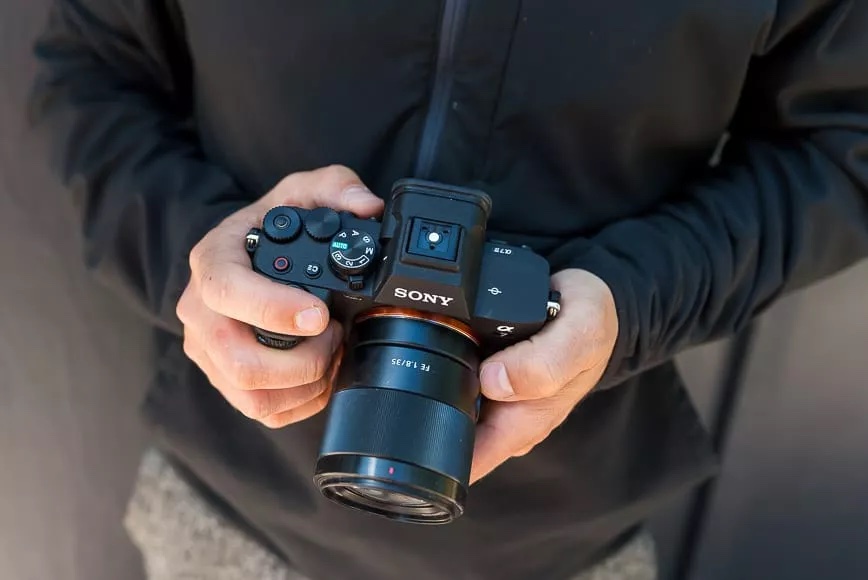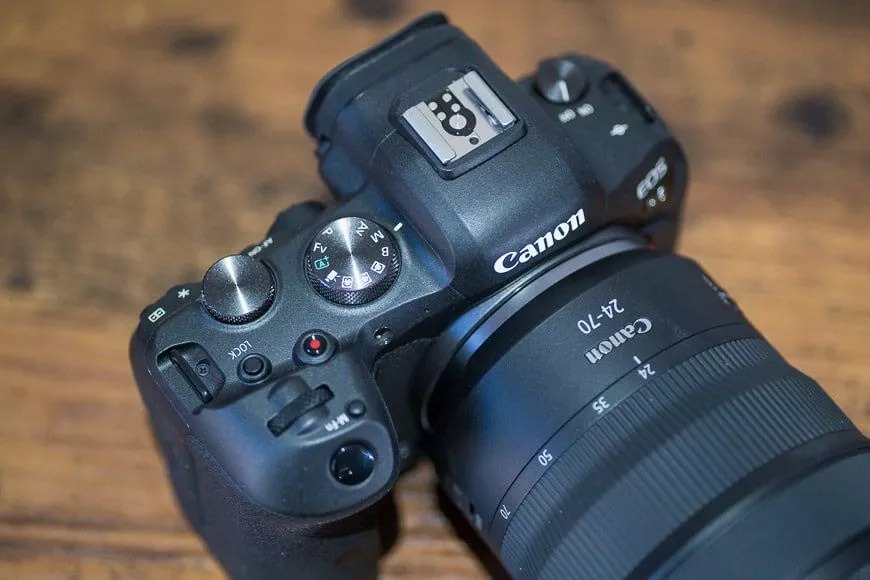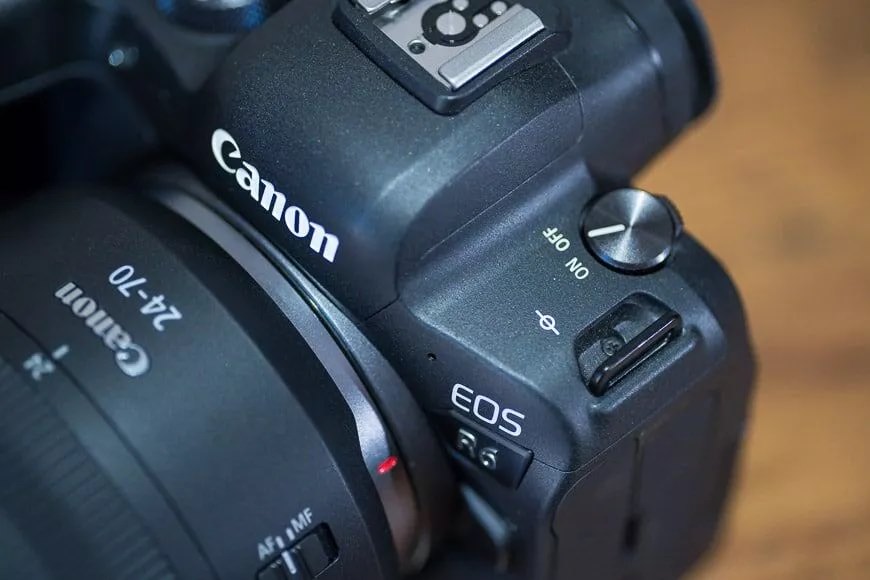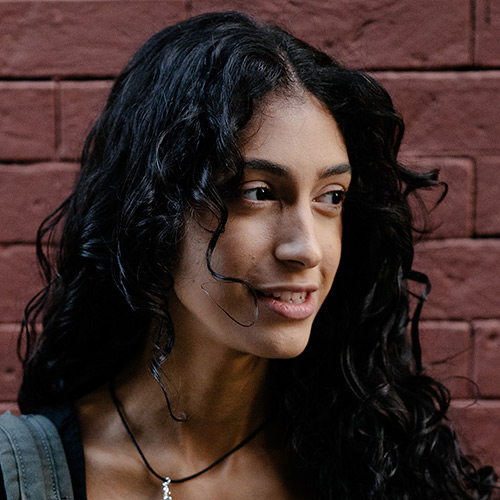
10 Great Mirrorless Cameras That We Love This Year
Mirrorless cameras offer better features than DSLRs in smaller bodies, helping to make photography and film making easier. These are the models to consider.
Camera Gear Guides | Camera Guides | By Usnea Lebendig and Mark Condon | Last Updated: March 27, 2024
We tested the latest mirrorless cameras to bring you this definitive guide.
Whether you’re a beginner or an experienced photographer, you’re about to learn how to choose the perfect camera for your needs.
We’re a team of professional photographers and filmmakers, so investing in the best gear is critical.
Each camera we included below offers first-class image quality, features, build and value for money.
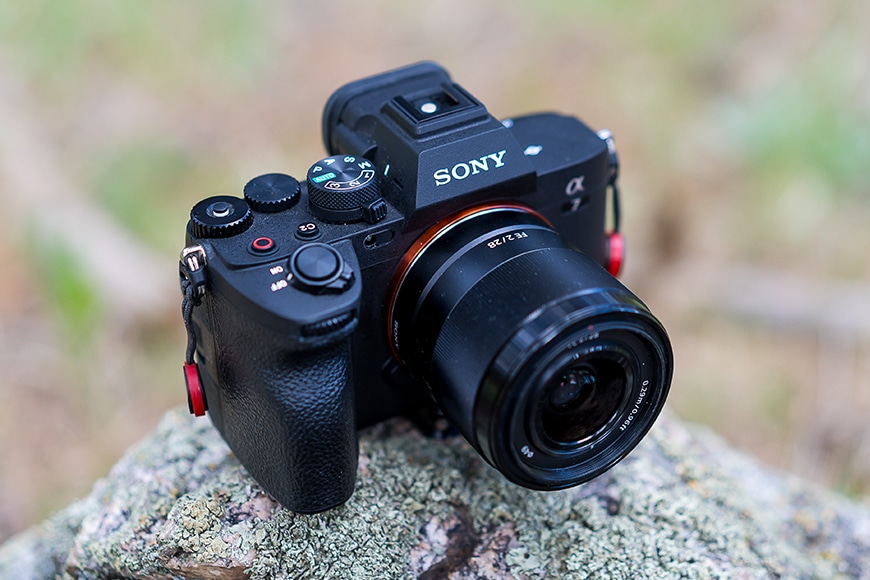
An all round powerhouse mirrorless camera, improving on its predecessor (last year's winner), with better autofocus, image quality, ergonomics and features.
Mirrorless cameras offer the latest technology to make photography easier than DSLR cameras.
They offer useful features like electronic viewfinders, high frame rates, complete AF area coverage and in-body image stabilization.
Let’s take a closer look at the top mirrorless options you need to consider this year.
What is the Best Mirrorless Camera in 2024?
| Image | Product | Features | ||
|---|---|---|---|---|
 | Canon EOS M50 MK IIBEST FOR BEGINNERS |
| CHECK AMAZON PRICE →CHECK B&H PRICE → | |
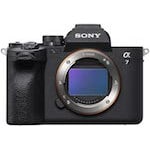 | Sony a7IVBEST FOR PROFESSIONALS |
| CHECK AMAZON PRICE →CHECK B&H PRICE → | |
 | Fujifilm X-T5BEST FOR ENTHUSIASTS |
| CHECK AMAZON PRICE →CHECK B&H PRICE → | |
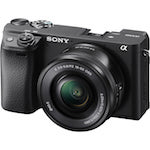 | Sony a6400BEST UNDER $1000 |
| CHECK AMAZON PRICE →CHECK MOMENT PRICE → | |
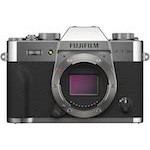 | Fujifilm X-T30 IIBEST FOR TRAVEL |
| CHECK AMAZON PRICE →CHECK MOMENT PRICE → | |
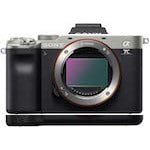 | Sony a7CBEST COMPACT FULL FRAME |
| CHECK AMAZON PRICE →CHECK B&H PRICE → | |
 | Sony a7R VBEST FOR OUTDOOR PHOTOGRAPHY |
| CHECK AMAZON PRICE →CHECK B&H → | |
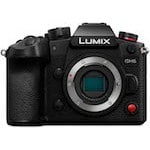 | Panasonic Lumix GH6BEST FOR VIDEO |
| CHECK AMAZON PRICE →CHECK B&H PRICE → | |
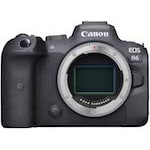 | Canon R6BEST FOR WEDDING PHOTOGRAPHY |
| CHECK AMAZON PRICE →CHECK B&H PRICE → | |
 | Nikon Z6BEST BUDGET FULL FRAME |
| CHECK AMAZON PRICE →CHECK B&H PRICE → |
Sony a7IV – Best Full Frame Mirrorless Camera for Professionals

Images: Marc Bergreen for Shotkit
- Superb image quality
- Excellent low-light performance
- Updated AI-powered autofocus.
- 5-axis in-body image stabilization
- Fully articulating rear screen
- AF tracks subjects at up to 10fps
- New breathing compensation mode
- Eye AF available in video mode
- 4K video at 60p with 10-bit color sampling
- Smart subject recognition
- Live stream capable
- Full-size HDMI port
- Excellent battery life
- Extremely customizable
- Much improved menu system
- Rich lens library
- Durable weather-sealed body
- Only 6fps at highest quality settings
- Rolling shutter
- Heavier than the A7III
- No Pixel Shift multi-shot mode
- LCD resolution screen not as strong as competitors
- Eye detection not yet 100%
- Expensive
Sensor: Full-frame | Resolution: 33 megapixels | Viewfinder: 3.69M dots | Monitor: 3-inch fully-articulated touchscreen, 1.04M dots | Autofocus: 425 points | Max frame rate: 10fps | Video: 4K at 60p | Weight: 659g (1.45 lb)
If you’re familiar with the mirrorless camera market at all, then you’ve probably heard about the excellence of the Sony A7III. At the time it was released, it was at the top of its class in just about every department. Now, in 2024, we finally have the next generation: the Sony a7IV.
Like the a7III, the Sony a7IV is a full-frame digital camera favored by professionals who work with a wide range of subjects and genres.
It can do just about anything, and anything it does, it tends to do really, really well, which is why we’ve picked it as the top mirrorless camera for professionals.
The new 33MP full-frame sensor is a huge jump up from the 24MP sensor in the a7III. Images come out superbly rich in detail, with true color and plenty of room for highlight and shadow recovery. (Sony finally removed the annoying green cast that plagued the a7III.)
Photographers who work in low-light conditions will love the dynamic range of this impressive full-frame mirrorless: standard ISO runs from 100-51200 with an extended range of ISO 50-204800. In practice, there’s virtually no noise up to 8000 ISO.
- Flip out screen can face forward for vlogging and selfies.
- Sony A7IV with shutter closed to block out dust.
- Ergonomics have greatly improved over its predecessor with a deeper grip and better buttons.
- Sony A7IV + Sony 16-35mm f/2.8 | 1/4000 f2.8 ISO 200
Similar to the Sony a7III, the autofocus system on the Sony a7IV is both accurate and reliable. A key difference, though, is that the a7IV can detect and track animals even in video mode making it a great mirrorless camera for wildlife photography.
It can even follow subjects it’s unfamiliar with, using a combination of pattern detection, subject brightness, and color to help it stay locked onto the selected subject.
Advanced users will love how truly customizable the Sony a7IV’s autofocus system is – you can set it to do just about anything. That being said, just keeping it on simple settings is more than enough for most applications.
For those who shoot video, the a7IV comes with 10-bit capture, 4K video up to 60p, an XAVC HS compression option, and a new S-Cinetone color profile. There’s also the ability to live stream video over USB.
Other pluses include phenomenal battery life, 5-axis in-body image stabilization, an improved menu system, and a huge lens assortment. It’s also the most durable mirrorless camera I’ve used.
As with any camera, there are a few drawbacks to the a7IV. The first is that its burst shooting is fairly little slow (6fps) when image quality is set to its highest. This comes from the huge file size that shooting in 33 megapixels yields.
Beyond this, the rear screen isn’t as crisp as its competitors. The Sony a7IV is also considerably more expensive than its predecessor (in the $2500 range).
Otherwise, this is a fantastic hybrid full-frame camera for pros that shoot a wide variety of subjects and genres. It’s our choice of the best mirrorless full frame camera in 2024, despite fierce competition.
Its excellent image quality, exceptional low-light performance, powerful autofocus system and strong video capabilities, combined with its overall dependability make this one of the top mid-range mirrorless cameras for professionals and enthusiasts alike.
Canon EOS M50 Mark II – Great Mirrorless Camera for Beginners
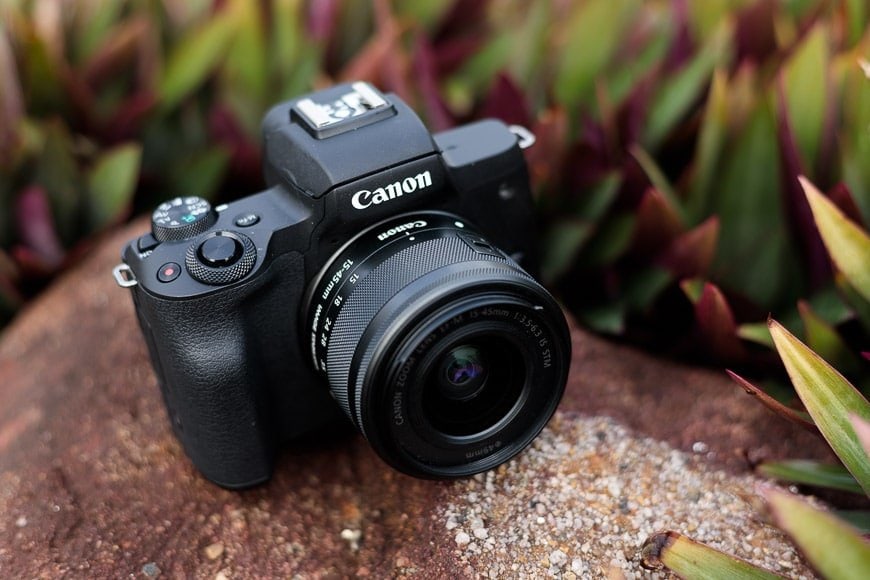
Image: Belinda Crossman for Shotkit
- Excellent still image quality
- Intuitive user interface
- Eye and face detection
- External microphone jack
- Vertical video recording
- Fully articulated LCD
- Compact and lightweight
- No Image Stabilization
- 4K video is heavily cropped
- Short battery life
- No USB charging
- Limited native lenses
Sensor: APS-C | Resolution: 24.1 megapixels | Viewfinder: 2.4M dots | Monitor: 3-inch fully articulated touchscreen, 1.04M dots | Autofocus: 143 points | Max frame rate: 10fps without AF, 7.4fps with AF | Video: 4K at 24p | Weight: 387g (.85 lb)
Suppose this is your first foray into the world of mirrorless cameras and/or you have never used a camera with interchangeable lenses. In that case, the Canon M50 Mark II is the best mirrorless digital camera to get started with.
Stills images come out nicely sharp, with pleasing colors and plenty of contrast. Video footage also comes out sharp with nice color.
Beginners can leave the settings on auto and still get fantastic images. When you’re ready to begin diving into the settings, though, you’ll find the standard Canon menu system both intuitive and easy to navigate.
If you’re brand new to photography, you can turn on the camera’s GUIDE mode, which simplifies things even further – most of the top mirrorless cameras for beginners should have some kind of basic mode like this.
The autofocus on the Canon EOS M50 Mark II is also easy to use, especially considering this is the best affordable mirrorless camera on our list. It’ll tenaciously lock onto subjects without much fiddling.
As part of the upgrade from the original M50, the Canon M50 Mark II now has eye-detection – along with AF support while recording video.
The body of the Canon M50 Mark II is relatively small and lightweight compared to many other mirrorless cameras, making it an easier step up from a smartphone than clunkier cameras (especially comparable DSLRs). It definitely beats lugging around a DSLR camera like the Rebel T8i!
If you’re a social media content creator who primarily works in HD, you’ll love the video on this camera., The 1080p footage is beautiful.
There are also a couple of special features made especially for social media posting:
- The Vertical Video feature ensures that your clips play properly on smartphones.
- The movie self-timer allows for more setup time when you’re working alone and recording yourself.
- There’s even the ability to live stream to YouTube (if you have more than 1,000 subscribers and an image.canon account).
If, however, you’re really needing a camera that works well in 4K, you’ll have to move up to something like the Fujifilm X-T30 II.
The 4K/24p video on the Canon EOS M50 Mark II comes out heavily cropped and you can’t use the camera’s dual-pixel autofocus with it (4K video on the M50 II is contrast-detection only). This makes it more challenging to keep fast-moving subjects in focus. It also affects the eye-detection.
Overall, the Canon M50 Mark II is perfect for those looking for an entry-level mirrorless camera at an excellent price. It hits the sweet spot between easy handling, high performance, and affordability.
In fact, the price is so low – under $700 for the camera body + EF-M 15-45mm kit lens – that it more than qualifies as a budget mirrorless camera as well as the best beginner mirrorless camera.
- User manual
- Best Lenses for the Canon M50 Mark II
- Full Canon Mirrorless Camera List (Updated for Latest Releases)
Fujifilm X-T5 – Best Mid-Range Mirrorless Camera (APS-C)

- Impressive 40MP sensor
- Compact and lightweight design
- Effective in-body image stabilisation
- New tracking and eye detection modes
- Bluetooth and Wi-Fi connectivity
- Improved battery life
- 10-bit 4:2:2 video at 6.2K/30P
- A fun shooting experience
- Burst shooting has a limited buffer
- Autofocus isn’t as good as the competition
- Buffer fills quickly when shooting in RAW
- No battery grip
Sensor: APS-C | Resolution: 40 megapixels | Viewfinder: 3.69M dots | Monitor: 3-inch fully-articulated touchscreen, 1.84M dots | Autofocus: 425 points | Max frame rate: 30fps in crop mode, 15fps full resolution | Video: 4K at 60p | Weight: 557g (1.34 lb)
Fujifilm has continued to cement its reputation as one of the leading camera manufacturers for retro-minded photographers looking for a classic shooting experience.
It’s reflected in the aesthetic design of the Fuji cameras, which continues here with their excellent continuation of the X-T series with the X-T5.
Designed with vintage 35mm camera lovers in mind, the Fujifilm X-T5 is built with the same retro dials and materials that have helped make the series so popular.
This lightweight camera is only slightly larger than the X-T4, with a negligible increase in weight that’s barely noticeable and a pleasingly tactile grip that makes it feel great to hold.
It’s constructed from a combination of metal, rubber, and hard-wearing plastic, looking and feeling durable as well as stylish.
The classic dials and familiar layout make the X-T5 an ideal shooting experience for photo-first users who enjoy working manually, and it’s in this respect that it performs the best as a camera.
It features a crisp electronic viewfinder along with a sharp, two-way tilting rear screen to assist with more awkward compositions, which works in both landscape and portrait orientations.
Fuji has opted to revert from the controversial vari-angle screen found on the X-T4 and X-H2 cameras, believing, arguably rightly, that the current screen style is more appropriate for stills-heavy use.
The shots it produces are typically excellent, with the combination of phase-detect autofocus and auto-exposure via the electronic shutter making it easy to capture great images.
Fuji has made improvements to the autofocus algorithm compared to the X-T4, giving it the ability to detect a wide variety of moving subjects, from humans and animals to planes, trains, bikes, and cars.
While you have to select which of these subjects you wish to track in the menu system, it’s consistently accurate, and the various settings can be programmed into the camera’s custom modes.
Where the Fujifilm X-T5 falls short of its competitors is on the video front, although it does come with some new features, such as the inclusion of 6.2K video at 40p.
It’s in this regard that their decision to return to the previous LCD screen format has left video-centric users pulling their hair out since they’re no longer able to use the screen for monitoring the camera from the front.
With that said, it supports F-Log2, expanding the dynamic range over previous models, and introduces a new menu for Movie Mode that makes shooting video easier than before.
The Fujifilm X-T5’s real strengths are consistent with the older models in this range; that is, it’s a fantastic performer for photographers who want something light, sharp, and fun to use while shooting street photography and other fast-paced action.
The inclusion of new Film Simulation modes and all-around improvements to image quality thanks to the new X-Processor 5 processing power strengthens the Fujifilm X-T5’s position as one of the best APS-C cameras you can buy today.
Fujifilm has continued to cement its reputation as one of the leading camera manufacturers for retro-minded photographers looking for a classic shooting experience.
It’s reflected in the aesthetic design of the cameras, which continues here with their excellent continuation of the X-T series with the X-T5.
Designed with vintage 35mm camera lovers in mind, the Fujifilm X-T5 is built with the same retro dials and materials that have helped make the series so popular.
This lightweight camera is only slightly larger than the X-T4, with a negligible increase in weight that’s barely noticeable and a pleasingly tactile grip that makes it feel great to hold.
It’s constructed from a combination of metal, rubber, and hard-wearing plastic, looking and feeling durable as well as stylish.
The classic dials and familiar layout make the X-T5 an ideal shooting experience for photo-first users who enjoy working manually, and it’s in this respect that it performs the best as a camera.
It features a crisp electronic viewfinder along with a sharp, two-way tilting rear screen to assist with more awkward compositions, which works in both landscape and portrait orientations.
All in all, it’s the best mid range mirrorless camera with an APS-C sensor money can buy right now.
Sony a6400 – Best Entry Level Mirrorless Camera (Under $1000)
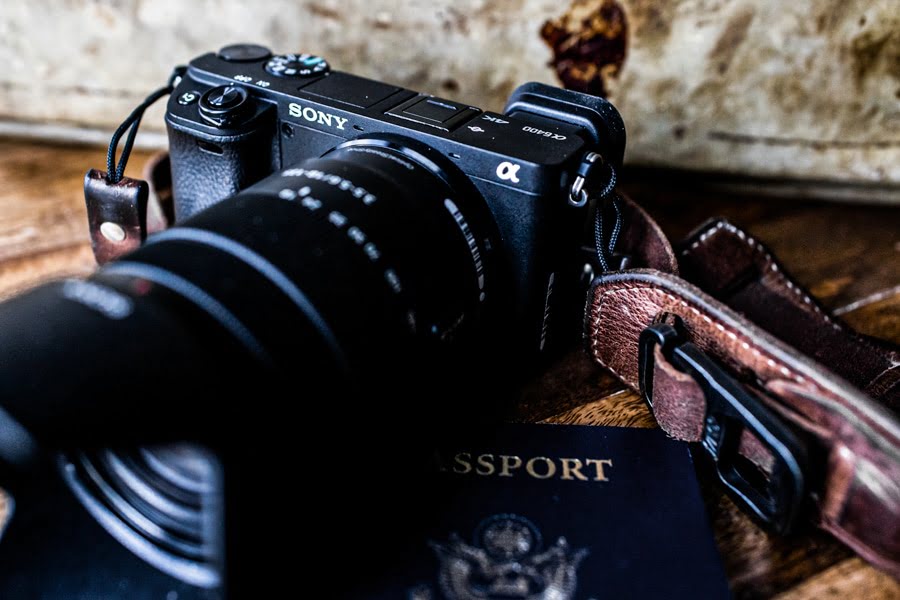
Images: The Starks for Shotkit
- Fantastic autofocus system
- Excellent image quality
- Compact body
- Flip-up screen for vlogging
- Beautiful oversampled 4K footage
- Wide selection of lenses
- Good battery life
- Great value for the $$
- Great as a webcam
- Single SD card slot (UHS-I only)
- No IBIS
- Limited external controls
- Complex menu system
Sensor: APS-C | Resolution: 24.2 megapixels | Viewfinder: 2,359k dots | Monitor: 3-inch tilt-angle touchscreen, 921K dots | Autofocus: 425 points | Max frame rate: 11fps | Video: 4K at 30p | Weight: 403g (.89 lb)
The Sony a6400 gets our vote for the best budget mirrorless camera, sitting midrange in the Alpha lineup.
It’s not flashy, nor the latest model in the long line of Sony a6 APS-C sensor cameras, but it’s a solid performer, has great image quality, and allows you entry into Sony’s well-stocked lens library. It’s also a great value for the money, coming in at less than $900.
One reason we love our Sonys is because of the fantastic autofocus system. The AF in the Sony a6400 is fast, reliable, and works equally well with both stills and movies. The real-time Eye AF makes it particularly easy to lock on to moving objects and nearly instantaneously adjusts to changes in the distance.
Images from the Sony a6400 come out nicely rich, with excellent color and contrast. There’s also plenty of dynamic range to work with, with a native ISO 100-32000 (102400 expanded).
For video shooters, the Sony a6400 offers excellent UHD 4K video quality from oversampled 6K. Frame rates at this resolution go up to 30fps and use the entire sensor area.
(The a6400 is also my favourite mirrorless camera for webcam use due to its excellent autofocus, high-quality video capabilities, forward facing screen and handy microphone input.)
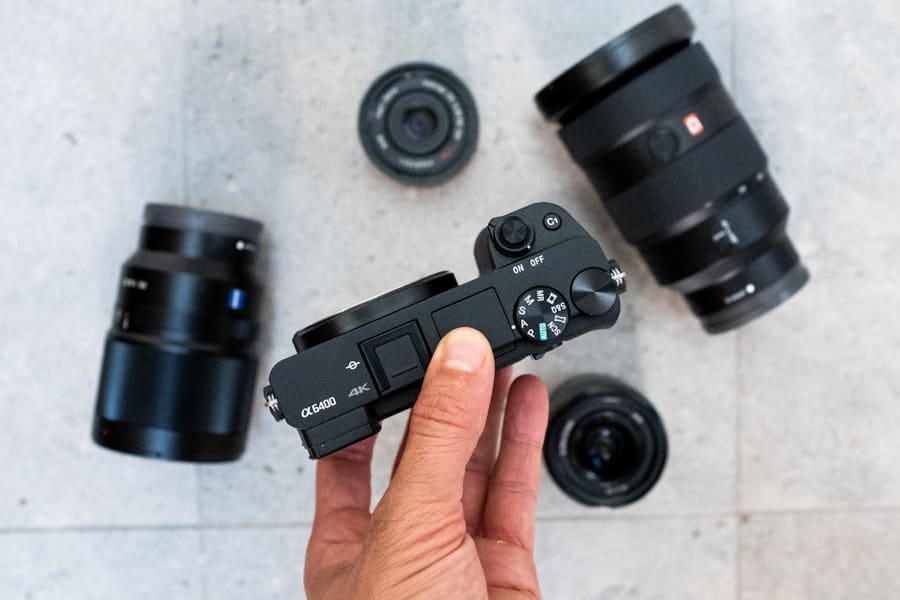
So many great Sony APS-C lenses are available for the a6400.
If you want something beyond 30fps, the 1080p resolution goes up to 120p. You can also shoot slow-motion footage directly in SQ mode.
Other video features include HLG (Hybrid Log Gamma) and Sony’s S-Log2 and S-Log3 gamma modes. The flip-up screen is also a plus, making selfie composition and vlogging easy. There’s also a full-size HDMI port.
Build-wise, the a6400 is definitely a small mirrorless camera – paired with prime lenses you also end up with a fantastically light, portable setup you can take almost anywhere.
The battery life is also excellent, with 360 shots via the optical viewfinder and 410 via the rear LCD screen.
While you can find cheaper mirrorless cameras than the Sony a6400, buying into the Sony ecosystem of E-mount lenses puts you in an excellent position if and when you’re ready to upgrade to a full-frame mirrorless camera.
It’s good enough for semi-professional usage, producing excellent image output from a tiny body.
Overall, the Sony a6400 is an excellent APS-C mirrorless camera at a low cost compared to fullframe models.
It doesn’t have built-in image stabilization and is so small the ergonomics won’t work for everyone, but it can do just about anything the average shooter needs it to do.
Fujifilm X-T30 II – Convenient Mirrorless Camera For Travel

Image: Greg Cromie for Shotkit
- Superb out-of-camera Jpegs
- Excellent autofocus
- Same sensor as the X-T3
- Compact body
- Great burst rate
- High-quality 4k video
- Strong eye/face detection
- Ergonomics could be better
- No IBIS
- Rear LCD doesn’t articulate
- Short battery life
- Single SD card slot (UHS-I only)
- 4K video only 10 minutes at a time
Sensor: APS-C | Resolution: 26.1 megapixels | Viewfinder: 2.36M dots | Monitor: 3.0-inch tilt-angle touchscreen display, 1.62M dots | Autofocus: 2.16 million phase AF pixels | Max frame rate: 30fps cropped, 8fps full resolution | Video: 4K at 30p | Weight: 378g (.83 lb)
The next iteration of the hugely popular Fujifilm X-T30, the Fujifilm X-T30 II, packs a huge amount of power and performance into a smaller, lighter body, making it the perfect traveler’s camera.
It’s my choice of the best hobbyist mirrorless camera in terms of bang for your buck – you get a lot of the features of the flagship X-Series models at a fraction of the price.
It’s also my favorite mirrorless camera for travel due to its portability, range of affordable lenses, and the fact that it’s cheaper than the other models in this guide, making you more likely to take it out with you on holiday.
On the outside, the Fujifilm X-T30 II features Fujifilm’s traditional retro style, with manual dials controlling the ISO, shutter speed, and exposure compensation.
Under the hood of this diminutive digital camera is Fujifilm’s latest 26.1-megapixel sensor and X-Processor 4, both of which also feature in the X-T4 – not the latest mirrorless camera released by the brand, but still an excellent device nevertheless.
While not quite as advanced as the Sony a6400, the X-T30 II’s phase-detect autofocus system is quite snappy and nicely covers the full frame – when comparing Fuji vs Sony cameras, it’s often the case where Sony is superior for AF performance.
You can see the face/eye detection in action below, courtesy of Fujifilm.
The 8fps continuous shooting at full resolution isn’t the fastest, but you can bump it up to 30fps if you’re ok with a 1.25x crop.
The 4K video at 30fps comes out quite pleasing, and if you bump down to Full HD, you can shoot at up to 240p for a 6x slow motion effect.
There isn’t IBIS, 10-bit capture, or any Log modes, so serious movie makers looking for a compact mirrorless might need to look into the Sony a6400.
In fact, Fujifilm X-T30 II and the Sony a6400 are quite similar in price, but the X-T30 II is a bit smaller and lighter than the Sony a6400 and has Fujifilm’s retro body design and unique color technology.
In the end though, if the weight difference isn’t a huge issue, which camera you choose will probably come down to which camera ecosystem you’re looking to enter.
Sony a7C – Best Compact Mirrorless Camera (Full-Frame)

Image: Marc Bergreen for Shotkit
- Full-frame sensor in compact APS-C-sized body
- Fantastic autofocus
- Articulating LCD (swivel screen)
- Excellent image quality
- IBIS
- Real-time tracking
- Mic and headphone sockets
- Best-in-class battery life
- Ergonomics are only so-so
- Electronic viewfinder is on the small side
- 4K maxes out at 30fps
- Uses Sony’s older menu system
- No built-in flash
- Expensive
Sensor: Full-frame BSI-CMOS| Resolution: 24 megapixels |Viewfinder: 2.36M dots | Monitor: 3-inch, fully articulated touchscreen, 921K dots |Autofocus: 693 points |Max frame rate: 10fps |Video: 4K at 30p | Weight: 509 g (1.1 lb)
Want the image quality of a full-frame sensor but a camera that won’t weigh you down? Take a look at the Sony a7C – one of the smallest full-frame mirrorless cameras available.
Feature-wise, the Sony a7C packs all the punch of a Sony a7 III, but adds in better autofocus and somehow fits all this high-end performance into a smaller, lighter body. Pair it with the retractable 28-60mm F4-5.6 lens and you get a remarkably small footprint, yet fantastic photos.
The autofocus system is simply fantastic in this little camera, with the real-time tracking recognizing human heads, faces, eyes, and animals, and locking onto them with ease.
Image quality is as good as the a7 III (it’s the same sensor), there’s burst shooting up to 10fps, and the oversampled 4K video goes up to 30p (including 8-bit S-Log and HLG). It even comes with in-body image stabilization (which is critical in a camera this size).
Of course, you’re going to get some ergonomic tradeoffs once you start handling a body this small: there’s no built-in flash and the built-in viewfinder is definitely on the small side.
It’s also not as easy in hand as a larger camera with its somewhat awkward grip, which is why I’ve called it the best prosumer mirrorless camera.
On the plus side, you get great battery life (740 shots per charge), a fully articulating LCD swivel screen, and mic and headphone jacks.
All-in-all, this little gem makes for a stellar travel companion: it’s easy to keep with you and, like the Sony a7 IV, it will excel in just about any situation.
Sony a7R V – Best for Landscape (Outdoor) Photography and Portraits
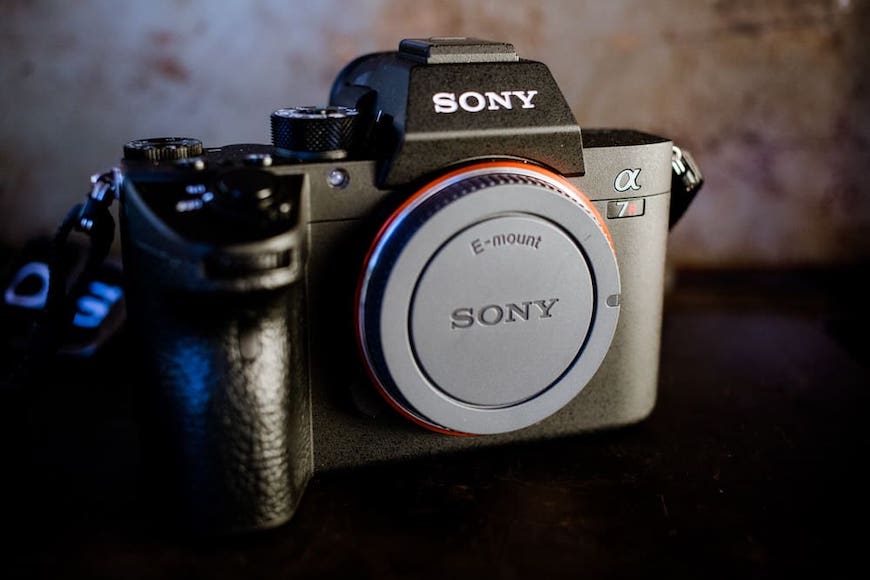
Credit Daniel Stark
- Stabilized 60MP full-frame sensor
- Improved electronic viewfinder
- Best autofocus mirrorless camera with subject recognition
- 8K/24p (cropped) or 4K/60p video
- Excellent AI-based focusing
- Vari-angle rear screen
- Enhanced IBIS
- Superb ISO handling
- Expensive
- Limitations on video
- Multi-shot mode requires Sony’s software to stitch
Sensor: Full-frame | Resolution: 61 megapixels | Viewfinder: 9,43M dots | Monitor: 3.2-inch tilt-angle touchscreen, 1.44M dots | Autofocus: 693 Phase + 425 Contrast | Max frame rate: 10fps with full AF / AE Tracking | Video: 8K at 24p/4K up to 60p | Weight: 723 g (1.96 lb)
As with the Fujifilm X-T5’s various improvements over the previous iteration, Sony’s A7R V has undergone a number of improvements over the A7R IV.
While it is built around the same 60MP BSI CMOS full-frame sensor as the Mark IV, the addition of more powerful processors gives the new model significantly more clout.
Perhaps the main area that benefits from this ramped-up processing power is autofocus, which offers far better subject recognition that goes well beyond human subjects.
A range of vehicles and animals can now be identified and tracked with ease, opening up the potential for shooting all manner of subjects with rapid AF.
Users now have the option to tailor the specific parameters for each of these subject categories to fine-tune how tolerant and sensitive AF is while tracking.
The upgraded algorithms extend into the Sony A7R V’s in-camera stabilisation of up to eight stops, which works in combination with Sony’s native lenses for a rating of 8.0EV in industry-standard tests.
Image quality is excellent whether shooting photos or recording videos, although to optimise the end results, it’s best to use lenses from Sony’s G and GM ranges.
While the design is similar to the A7R IV, there’s an improved 4-axis 3.2-inch articulating screen, making it a more viable option for video content creators than its predecessor.
Sony has also improved the viewfinder, delivering a high-magnification 0.9x optics for a bigger view of the frame, along with a 9.4 million dot display.
The body comes in an attractive matte black finish and magnesium alloy for the chassis, with dust and splash protection along with the option to close the shutter down when changing lenses.
The previously marked, dedicated EV control is now unmarked, and while it is still set to EV as default, it can be easily swapped out for another function.
There’s also a new toggle beneath the Mode dial dedicated to Stills/Movie/Slow Motion, which is a nice new touch that may speed up the workflow for some users.
Videographers and content creators can enjoy the inclusion of 8K video – albeit cropped – as well as introducing S-Log3, S-Cinetone and HDR formats that were lacking from the A7R IV.
This makes the Sony a7R V a wonderful camera for video content creators and filmmakers who want to really fine-tune their footage in post, with a more dynamic range to adjust colours and push blacks.
The aforementioned improvements to the autofocus also ensure a far more accurate and reliable experience with video, tracking subjects accurately even in busy scenes as they move around the frame.
With that said, the benefits from the updated in-body image stabilisation aren’t as apparent when shooting video footage, with rapid movements and other jolts prone to negatively impacting the footage.
There are also issues with the rolling shutter when shooting in 8K and full-frame 4K, although these issues can be avoided by shooting in APS-C mode.
The Sony A7R V brings plenty of reasons to the table to earn a strong recommendation, with outstanding image quality and all-around improved engineering combined with game-changing AI-based autofocus and stabilisation.
Panasonic Lumix GH6 – Popular Mirrorless Camera For Video
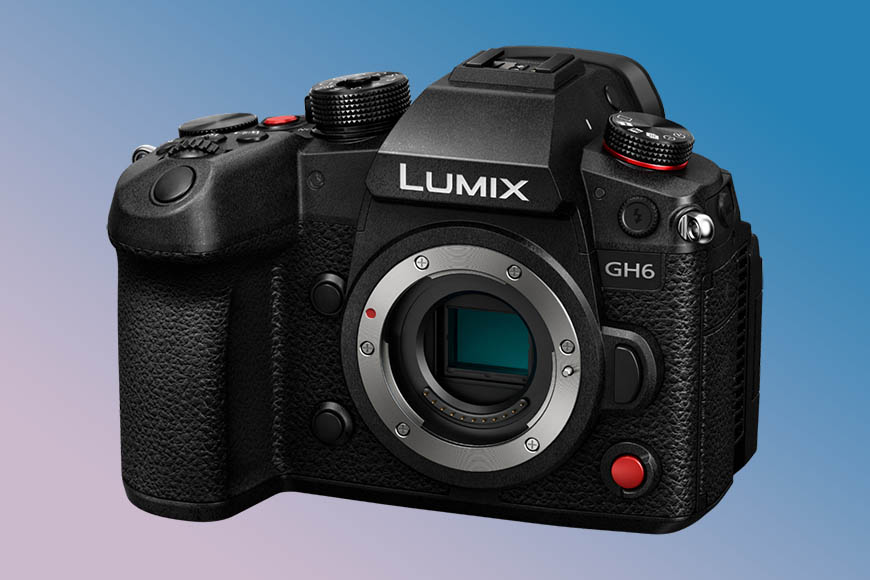
- Ergonomics designed specifically for filmmaking
- Unrivalled video toolkit
- Internal ProRes 422 HQ support
- Best-in-class image stabilization
- Subject recognition for people and animals
- Weather-sealed
- Active cooling for long-form recording
- Only has phase detection autofocus
- Battery life could be better
- Excessive noise when lifting shadows in RAW stills
- Cooling fan is noisy
Sensor: Live MOS Micro-Four-Thirds | Resolution: 25.2 megapixels | Viewfinder: 3.68M dots | Monitor: 3-inch free-angle tilting touchscreen, 1.84M dots | Autofocus: 315 Contrast | Max frame rate: 14fps | Video: 5.7K at 30p; 4k at 60p | Weight: 823 g (1.8 lb)
When one thinks of video, one doesn’t usually think of micro four-thirds cameras, but the Panasonic Lumix DC-GH6 bucks the trend. It was designed specifically for use as a video camera, both in the build and in feature set, and it beats out all other video cameras in its class.
While the still image options are just passable (mostly due to the phase detection autofocus and sub-par RAW files), for videographers the GH6 is simply fantastic.
Sure, the micro four-thirds isn’t the largest sensor size, but the Lumix DC-GH6 manages to hold its own in terms of resolution performance, particularly in its All-I codecs, which top out at 10-bit 4K/60p 4:2:2. It also produces footage far beyond any of its competitors when shooting at 4K/120p.
One would expect the GH6 to perform poorly in low light given its micro four-thirds sensor, but the Lumix GH6 actually rivals the a7S III for detail and high ISO noise management (at last up until ISO 12,800).
As mentioned before, the autofocus is only phase detection, but comes with subject recognition (both human and animal) and works on third-party micro four-thirds lenses as well.
But it’s in the video department that this little micro four-thirds camera excels. The list of recording options is over the moon – at least for a mid-range mirrorless camera.
Headliners include Apple ProRes 422 and ProRes 422 HQ recording (currently on at 5.7K resolution in 24p, 25p or 30p, but soon also to include 4K video and FullHD via firmware update). There’s also the ability to record in full V-log.
As far as physical recording is concerned, the Lumix GH6 has two card slots: one for UHS-II SD, and one for the more advanced CFexpress Type B card.
It can record Cinema 4K footage at 60p to both its cards simultaneously, as well as externally via HDMI to a recorder. A firmware update coming soon promises to add recording to a solid state drive as well.
Video shooters will also love:
- the sub-video record button on the front, as well as on the top plate
- the dedicated audio management button in place of the picture profile button
- the anti-rotation pinhole in front of the tripod thread
- the Lumix Luminance Spot Meter, Waveform and VectorScope
Suffice it to say, that even the most passionate and unique filmmaker should find what they need in this little camera.
The Lumix GH6 also comes with an excellent 5-axis in-body image stabilization system rated at 7.5 stops, eliminating the need for a gimbal in many situations.
Honestly, one would be hard-pressed to find a digital camera with a more comprehensive list of high-quality recording options – especially for under $2000.
For video, it outperforms most other mirrorless cameras, including its main micro four-thirds competitor, the Olympus OM-1. Even full-frame cameras like the Canon EOS R6 can’t really match it in the video department.
That being said, the Lumix GH6 is a bit lacklustre in the stills department, so if you need a true hybrid camera you’d best look elsewhere. However, we stand by our decision of it being the top mirrorless camera for video and think you’ll love too.
Canon R6 – Great Option for Wedding Photography
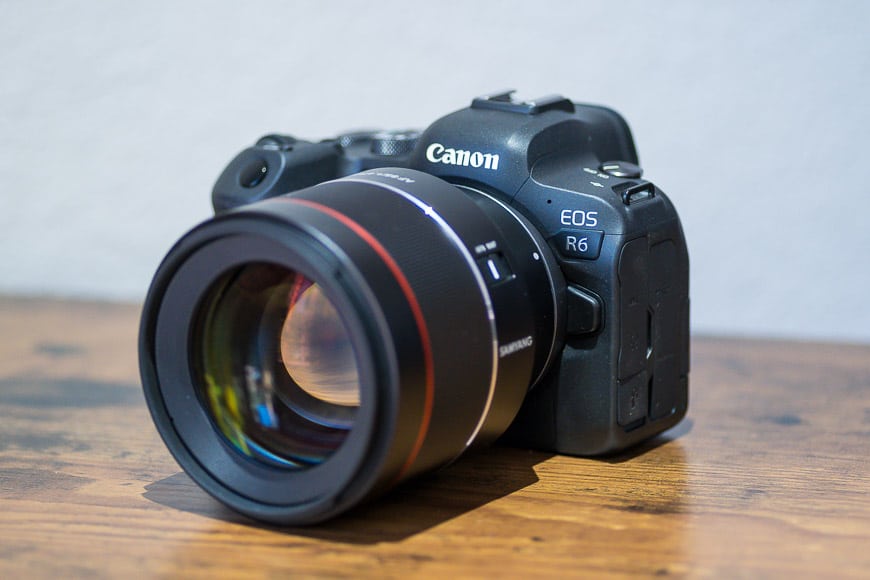
Images: Marc Bergreen for Shotkit
- Excellent ISO range and low-light performance
- Max burst speed of 20 fps
- 8-stop IBIS
- Solid build quality
- ISO range of 100-102400; expandable to 204800.
- Lacks tactile controls
- Only 20 MP
- Expensive
Sensor: Full-frame | Resolution: 20.1 megapixels | Viewfinder: 3,690K dots | Monitor: 3-inch fully-articulated touchscreen, 1.62M dots | Autofocus: 273-points | Max frame rate: 20 fps electronic/12 fps mechanical| Video: 4K at 60p | Weight: 680 g (1.5 lb)
Wedding photographers need a quick, high-capacity camera that can perform across a huge range of photographic challenges, all while cranking out excellent images. The Canon EOS R6 does all of this and more.
For a full-frame camera, the Canon EOS R6 is nicely compact, yet well-balanced. Its solid build can hold up to even the rowdiest wedding.
The image quality of the Canon EOS R6 will please even the pickiest of clients, and the superb ergonomics will make long shooting sessions much easier on the photographer. It feels great in the hand, key controls are well-positioned, and the buttons are all customizable.
The R6’s full-frame sensor is only 20 megapixels, more than enough for the vast majority of wedding photography applications unless you’re needing a huge billboard of an image or tend to highly crop your photos.
In fact, the low-megapixel count is actually an advantage to many wedding photographers, as the small file size of the photos makes it much easier to process and store the literally thousands of images you’re likely to end with. (It’s one reason the Canon EOS R6 is often favored over the Sony a7IV – it’s remarkably easier to quickly sort through 20-MP files than 33-MP files.
Also, the Canon EOS R6’s fantastic ISO range and low-light performance easily compensate for the low megapixel count. There’s also 8-stops in-body image stabilization, to help with landing those tricky, handheld shots.
- Canon EOS R6 controls are intuitive and accessible.
- Canon EOS R6 + Canon 24-70mm f/2.8 RF
- Canon EOS R6 back screen rotates completely to face forward.
- Canon EOS R6 + Samyang 85mm f/1.4 RF | 1/8000 f/2.2 ISO 800
Need to get some action shots of the couple dancing? No problem! The Canon EOS R6 has burst shooting up to 12 fps with its mechanical shutter and up to 20 fps with its electronic (silent) shutter.
The Dual Pixel AF II autofocus system is a solid performer and comes with machine learning and subject tracking. There’s not much need for fine-tuning – it just works.
On the video side of things, the Canon EOS R6 comes with offers 4K video up 60fps, and 1080p up to 120fps. There’s also 10-bit 4:2:2 with Canon Log or HDR PQ. Internal recording is available in all formats, and all have autofocus. Hybrid users will be pleased to find that switching between video and stills is fairly quick.
There are a couple of caveats, though. Any camera use can eat into its 40-minute limit. In addition, the rolling shutter can sometimes affect the footage.
Still, there’s not much else to complain about with this excellent little full-frame camera. It can do just about everything the Canon EOS-1D X III can do, yet in a compact, mirrorless body.
It also has a very similar dynamic range to the more expensive EOS R5, which we think is overkill for most photographers.
The R6 is simply one of the most popular mirrorless cameras for wedding photographers, as well as anyone else looking for a high-performing mid-range mirrorless camera in the RF-lens-mount world.
Sure, it may not be the absolute best Canon mirrorless camera with the formidable R5 taking the top spot, but for the money, it can’t be beaten.
Nikon Z6 – Best Value Mirrorless Camera
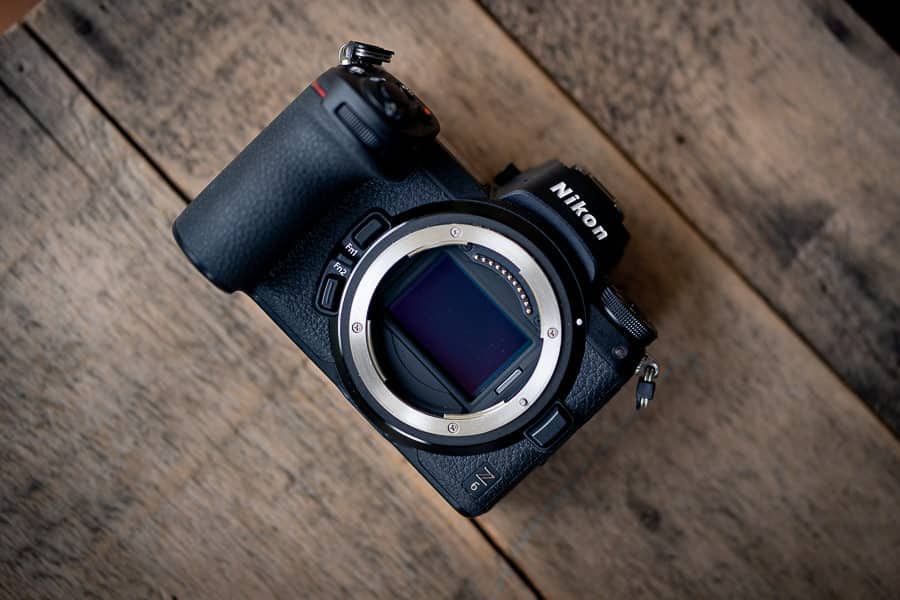
Sensor: Full-frame | Resolution: 24.5 megapixels | Viewfinder: 3,690K dots | Monitor: 3.2-inch tilt-angle touchscreen, 2,100K dots | Autofocus: 273-points | Max frame rate: 12fps | Video: 4K at 30p | Weight: 675 g (1 lb 7.9 oz)
- Amazing value for money
- Great ergonomics
- Excellent high ISO performance
- 5-axis stabilization
- 12fs burst shooting
- Super high-res EVF
- Stunning 4k video
- Limited buffer
- Limited native lens selection
- XQD card format is expensive
- Average battery life
Nikon’s answer to the amazing Sony mirrorless cameras came out a few years ago with the launch of the Nikon Z6 and the 46MP Nikon Z7.
Nikon has since released newer models, but with the significant price increases of the Z6II and Z7II, we’ve chosen the original Z6 as our best budget mirrorless camera of the year.
While the Z7 series is more of a landscape and portraiture camera, the Z6 is – like the Sony a7 III – an impressive, more affordable all-rounder. In fact, it’s probably Sony’s closest competitor – see our comparison: Nikon Z6 vs Sony a7 III.
The Nikon Z6’s full-frame 24.5-megapixel sensor ensures high resolution images without going overboard in file size, while the native ISO range of 100 to 51,200 to (expandable 50 to 204,800) gives it a dynamic range that rivals the class-leading mirrorless cameras.
The Z6’s build quality is top of the line, with the ruggedness we’ve come to expect from Nikon bodies. In fact, it’s still one of the best-built mirrorless full-frame cameras on the market right now, with great ergonomics to match.
Nikon camera owners will find its controls and menus quite familiar, as they mirror Nikon’s DSLR line. There’s even a top plate LCD that DSLR shooters will readily appreciate.
One thing that is quite different, though, is the lens mount. Nikon ditched the old F-mount in lieu of the new Z-mount, which is designed to let in more light to the Z-series sensors.
There still aren’t many native lenses available for either the Z6 or Z7, but luckily most F-mount lenses will work just fine with the new FTZ mount adapter, although at around $250 it’s not cheap.
Another thing that stands out in the build of the Nikon Z6 is the fantastic electronic viewfinder. It’s crisp, clear and boasts an exceptionally high resolution.
The downside of this is that the 60Hz refresh rate is a bit slow, especially when shooting in burst mode. The touchscreen is also quite beautiful, but for some reason lacks touchscreen autofocus while you’re looking through the viewfinder.
Speaking of autofocus, the Z6 keeps up with more of the recent mirrorless cameras in most situations, although loses out in low light. It also does a reasonably good job of tracking subjects, both at 5.5 fps (with live view) and 9 fps (no live view).
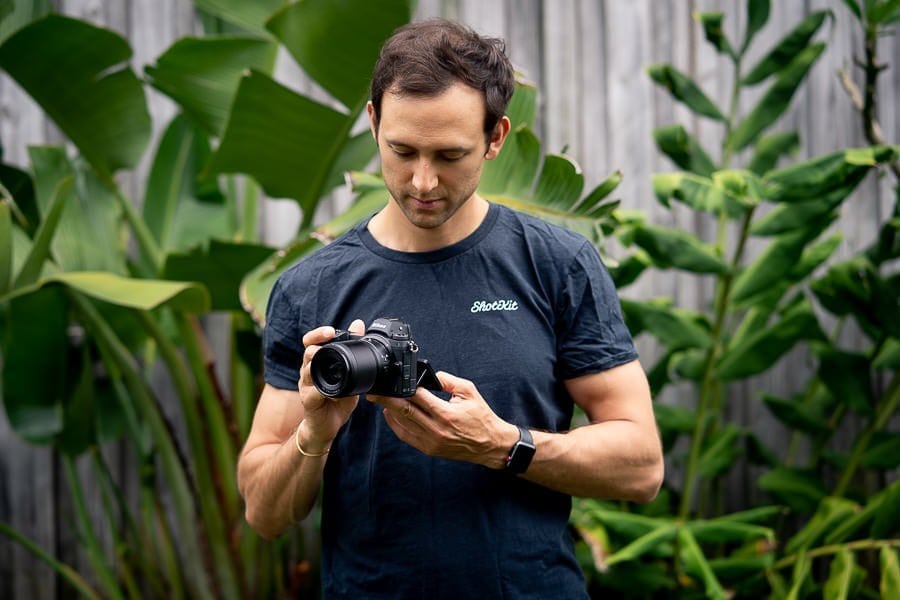
The tilting LCD screen of the Nikon Z6 makes it easy to compose from above or below.
As far as movie footage is concerned, no disappointments here. The Z6’s 4k movie footage is simply stunning, with frame speeds up to 30p for 4K UHD, as well as Full HD video in 60p and 120p slow-motion in HD.
As expected, the Nikon Z6 also comes with plenty of capture tools, including 10-bit Log output.
Like the Sony a7 line, the Nikon Z6 comes with effective 5-axis image stabilization, allowing you to handhold it in low light and still achieve steady shots, even at 0/5~1 second shutter speeds!
One thing of note is that Nikon opted to go with a single XQD card slot rather than dual card slots. That’s a bit of a gamble, as at the moment there aren’t a lot of XQD cards available, and not having an immediate card backup may deter uses for professional photography.
Still, if you’re a Nikon lover and especially if you’ve already invested in Nikon glass, the Nikon Z6 is a great mirrorless option, and an absolute bargain right now. It keeps up with the Sony a7 III in many respects and exceeds it in build quality and EVF quality.
The Z6’s autofocus system lags a bit behind the a7 III’s and the battery life isn’t quite up there, but in general, it’s still a solid full-frame mirrorless camera that every Nikon lover should consider, especially at this price point.
What are the Advantages of a Mirrorless Camera?
- Less weight and bulk – Mirrorless camera bodies and most of the lenses made for them are smaller and lighter than corresponding DSLR cameras. While the difference may not be huge, if you’re someone who travels with a camera, every last ounce can make a difference after a long day of hauling gear around. On the flip side, adding a long zoom lens to a small body can make the setup a little unwieldly.
- Manual focus is much, much easier – Because you can see exactly what you’re doing, it’s extremely easy to manually set an accurate exposure and make sure you’re image is in focus. There are also tools like focus peaking and focus point magnification available.
- Live Histogram – With a mirrorless camera, you can see the histogram and overall exposure before you take the picture. While some DSLRs can show a histogram in Live Mode, none can show a live histogram in the viewfinder as you’re changing the camera settings.
- Exceptionally High Burst Rate – Most mirrorless cameras can leave DSLRs in the dust when it comes to burst rate.
- Silent Shooting – Mirrorless cameras can switch to “silent mode” and use their electronic shutter only. This means you won’t be interrupting the moment when doing wedding or event photography in a quiet space.
- Better Autofocus – Most mirrorless cameras have a high number of focus points, with the focus points much more spread across the entire frame than what you’ll find on an average DSLR.
- Longer Life Span – The life span of a DSLR is pretty much tied to the life expectancy of its shutter. With mirrorless cameras, because there’s no mirror to flip up and down, the shutter count does not matter as much.
Should I switch from DSLR to mirrorless?
Mirrorless cameras are the wave of the future: almost all of the R&D funding is going in that direction. It’s quite likely that DSLR development won’t keep up nor continue much into the future.
That being said, if you’re happy with your DSLR setup, then there’s no reason to switch to a mirrorless camera – at least any time soon.
Just beware switching over to a mirrorless camera won’t necessarily make you a better photographer. Sure, it’s much easier to shoot in manual mode and get your exposure correct, but the elements of creating a good photo haven’t changed.
You should also read the results of our survey to find out what cameras photographers use to see how many use each main format of camera.
What Should I Look for When Buying a Mirrorless Camera?
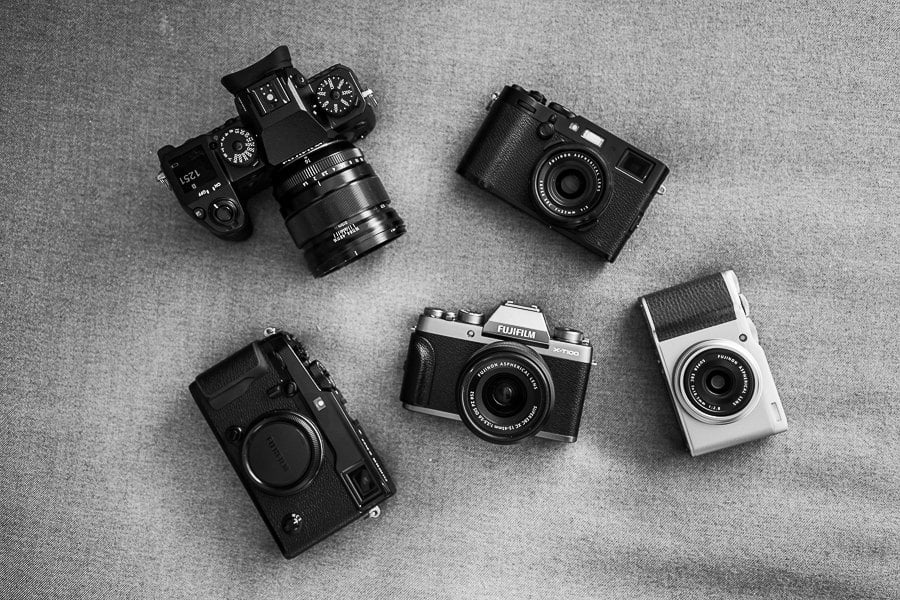
Fujifilm mirrorless cameras
- Sensor size – Sensor size makes a huge difference to image quality, especially when shooting in low light, but there are some trade-offs. For example, APS-C cameras tend to be smaller and lighter than full-frame cameras. They’re also less expensive.
- Budget – At the end of the day, which mirrorless camera you choose will ultimately come down to what you can spend on it…and on the lenses that you want to use on it. If you’re on a budget and can’t yet buy the camera you want, choose a cheaper version with the same lens mount. That way all your lenses can migrate over to the new camera.
- Resolution – These days it’s pretty common to find cameras offering 24 megapixels., which is more than enough for most applications. You likely won’t need more if you’re not planning on printing out your images. Also, keep in mind that higher resolutions provide better image quality, but also huge files.
- Lens Options – In many respects, the glass you buy will be more important than the camera – at least if you really want quality photos. If you see yourself content to shoot with a kit lens for a while, then buying into any ecosystem will be fine. If, however, you’re excited to invest in great glass and/or want flexibility in what you can choose, you’ll want to invest in a camera with a lens mount that has a great lens library (like the Sony E-mount).
- Autofocus – The autofocus on mirrorless cameras has really changed the game, especially when it comes to moving subjects. Make sure that the camera you want to buy has face, eye, and subject detection if you’re planning on doing any action or event photography.
- Burst Rate – Burst rate isn’t a big deal if you’re shooting static subjects. If your subject matter contains a lot of moving subjects, however, you’ll want at least a 10fps burst rate.
- Video Features – If you’re planning on using your new camera for video, take a look at the different recording options offered and make sure they’re the ones you’re planning to use now AND grow into. (i.e. maybe you haven’t shot a lot of slo-mo yet but might want to get into it in the future.) This includes physical features like a full-size HDMI port.
- Ease of use – what’s the easiest mirrorless camera to use? It depends on individual preferences and needs, but finding a model that fits your hands and has well-placed buttons is the first step. A MILC with plenty of customization options will also let you further adapt the camera to your needs.
What accessories should I consider buying for a mirrorless camera?
Some popular accessories you can consider to make your life shooting with a mirrorless camera more enjoyable include:
- Different lenses
- Memory cards
- Small camera bag
- Tripod
- External flash
- Battery Grip
- Remote Control
- UV Filter
While Sony mirrorless camera accessories and other brand-specific products are available, you’ll find more variety from third-party brands.
Sony Mirrorless Camera Lineup
Here’s a comparison table of the most recent Sony MLCs and their release dates:
| Model | Megapixels | Dimensions (W x H x D) | Weight (g) | Release Date |
|---|---|---|---|---|
| Sony A7R V | 60MP | 131 x 97 x 82 mm | 723 | October 2022 |
| Sony A7 IV | 33MP | 131 x 96 x 80 mm | 659 | October 2021 |
| Sony A1 | 50.1 MP | 136.9 x 97.3 x 81.0 mm | 699 | January 2021 |
| Sony A7R IV | 61 MP | 126.9 x 95.6 x 73.7 mm | 665 | July 2019 |
| Sony A7S III | 12.1 MP | 128.9 x 96.9 x 80.7 mm | 699 | July 2020 |
| Sony A7 III | 24.2 MP | 126.9 x 95.6 x 73.7 mm | 650 | February 2018 |
| Sony A6100 | 24.2 MP | 120.0 x 67.0 x 59.7 mm | 396 | August 2019 |
| Sony A6600 | 24.2 MP | 120.0 x 67.0 x 69.9 mm | 503 | November 2019 |
| Sony A9 II | 24.2 MP | 137.0 x 96.9 x 74.0 mm | 663 | November 2019 |
| Sony A6400 | 24.2 MP | 120.0 x 67.0 x 59.7 mm | 403 | January 2019 |
| Sony A9 | 24.2 MP | 137.0 x 96.7 x 63.0 mm | 673 | April 2017 |
| Sony A7R III | 42.4 MP | 126.9 x 95.6 x 73.7 mm | 657 | October 2017 |
What’s the cheapest mirrorless camera?
Some brands to consider for budget-friendly mirrorless cameras include:
- Sony Alpha series: Specifically the older models like the Sony a5000 or Sony a5100.
- Canon EOS M series: Cameras like the EOS M100 or EOS M50 (although the M50 is a mid-range camera, it’s sometimes available at a more affordable price).
- Fujifilm X series: Older models like the X-A5 or X-A7 might be priced lower.
- Panasonic LUMIX series: Models like the Panasonic LUMIX DMC-G7.
- Olympus OM-D series: Older models, in particular, can be more affordable, such as the E-M10 Mark II or III.
- Nikon Z series: The Nikon Z50, being an entry-level model in the Z series, is more affordable compared to its high-end counterparts.
Top Mirrorless Cameras FAQ
What is a mirrorless camera?
A mirrorless camera doesn’t have any moving mirror mechanism that’s found in DSLRs. This allows it to be smaller in particular and offers features such as electronic viewfinders, faster burst shooting, and real-time exposure previews.
Which brand has the most popular mirrorless camera?
In our opinion, Sony consistently makes the best full-frame mirrorless cameras. They have many more years of development under their belt than Canon or Nikon. For APS-C cameras, Fujifilm makes the popular mirrorless cameras.
Why are mirrorless cameras better?
Mirrorless cameras are smaller and lighter, with image quality that’s just as good as same-class DSLRs. Because they don’t have a mirror, they have a much faster frames-per-second rate than other cameras and even have a silent shooting mode. That’s something a DSLR camera just can’t do, yet it is often needed in quiet settings.
Do professionals use mirrorless cameras?
Yes, many professionals prefer using mirrorless cameras over DSLRs.
What are the disadvantages of mirrorless cameras?
The biggest disadvantage is that the sensor on a mirrorless camera is fully exposed when you change lenses. (On a DSLR, the mirror partially protects the sensor.) Also, many mirrorless cameras have sub-par battery life when compared to DSLRs.
Is DSLR still worth buying?
DSLRs are still worth buying if you already have a lot of EF and F-mount lenses or can get them inexpensively. Also, the prices of DSLRs are going down considerably – you can get some amazing deals now that mirrorless cameras are all the rage. Beyond this, they feel better in the hand (especially if you have large hands).
Is mirrorless the future?
Undoubtedly, mirrorless cameras are the face of things to come. It’s where the major camera manufacturers are putting in the bulk of their R&D and also where consumers are putting their dollars, which in turn influences further development.
What is the lightest mirrorless camera?
The Panasonic Lumix GX850 weighs approximately 329g (11.6 oz), and the Sony a6000 is 344g (12.1 oz) with a battery and memory card. The Sony a6000 is also the best cheap mirrorless camera.
What is the cheapest Fujifilm mirrorless camera?
The X-T200 can be found for around $700 and features a 24.2-megapixel APS-C sensor, a touchscreen LCD, and 4K video recording capabilities.
What mirrorless camera is best for family photography?
Any camera can be used for family photography, but if you need something small and intrusive for candid shots, the Fujifilm X-T30 or Sony a6400 is ideal. Pairing these cameras with a zoom lens will help you maintain adequate distances from families, ensuring they don’t get nervous in front of you.
Final Words
Choosing a mirrorless camera in 2024 isn’t an easy task, but hopefully, our guide has helped you make the right decision based on your needs.
Mirrorless cameras are fun and exciting to use, so they encourage you to get out and take more photos.
Feel free to leave a comment below with your questions and recommendations, and I wish you happy shooting!

An all round powerhouse mirrorless camera, improving on its predecessor (last year's winner), with better autofocus, image quality, ergonomics and features.







